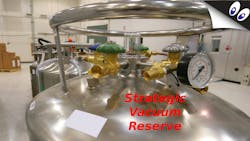Support America's Strategic Vacuum Reserve-- ACT NOW!
Series: April 1, 2020: What's Trending in Technology
Before and during the military buildup to American entry into World War II, tremendous quantities of high-quality vacuum were harvested for use in vacuum tubes of all sizes and shapes. In the post-war era, demand for cathode-ray tubes for television receivers further depleted supplies of vacuum of high and medium grades.
Tragically, many wells supplying military-grade vacuum have long since been depleted, leaving only lower-grade vacuum salvaged from mining activities available to meet all demands.
Similar post-war concerns for shortages of petroleum for fuel and industrial processes led to establishment of the Strategic Petroleum Reserve (SPR), an emergency fuel storage of oil maintained by the United States Department of Energy. As the largest emergency supply in the world, the SPR can accommodate up to 727 million barrels of oil.
Recent events in the Middle East and the United States have called attention to rapid increases in the consumption of even low-grade vacuum, mostly for political and theological applications. Researchers in the Pentagon and civilian think-tanks have awakened to the distinct possibility that obtaining decent vacuum of *any* grade may become difficult or impossible.
Noting stiff competition and higher consumption of vacuum by Chinese industries and military, the United States Vacuum Association, a trade association dedicated to restoring the previously-secure vacuum supply chain, has called upon the U.S. government to establish strategic reserves of high- and medium-quality vacuum.
While wartime vacuum repositories relied on sealed underground caverns left over from helium mining, intensive efforts are under way to render commercial and civic structures vacuum-tight to serve as interim storage facilities. Long-range strategic planning calls for multiple dispersed vacuum repositories to be located in or near areas of high demand and adjacent to current vacuum refineries.
Although unmentioned in news accounts, researchers aboard the International Space Station (ISS) are experimenting with techniques that allow compression and liquefaction of near-Earth medium-grade vacuum for shipment to Earth via returning Soyuz capsules. Speculative projections indicate that a space vehicle shuttling passengers and supplies from Earth orbit to Mars could acquire and process large enough quantities of diamond-hard deep-space vacuum on the trip's return leg to significantly offset costs of the round trip.
As a vacuum user, your support for creation of the new Strategic Vacuum Reserve and upgrading of the few remaining World War II-era repositories is critical to the program's success. You can help by contacting your Congressional and Senate representatives and calling their attention to this issue.
Remember... a good vacuum is a terrible thing to lose. Write your Congressman TODAY!
(This announcement is cosponsored by the American Vacuum Tube Institute and the U.S. Council on Consumer Vacuum Products)
About the Author
Bradley Thompson
B.S.E.E., University of Massachusetts
Now retired, Brad Thompson wrote and edited articles and columns for Test & Measurement World and EDN. As a freelance writer and reviewer for several publications, he covered personal-computer hardware and software products.
Prior to undergoing the obligatory corporate layoff in his mid-40s, he designed portions of military, industrial and agricultural electronic systems and served as a components engineer and consultant. He holds an Extra-class amateur radio license.
